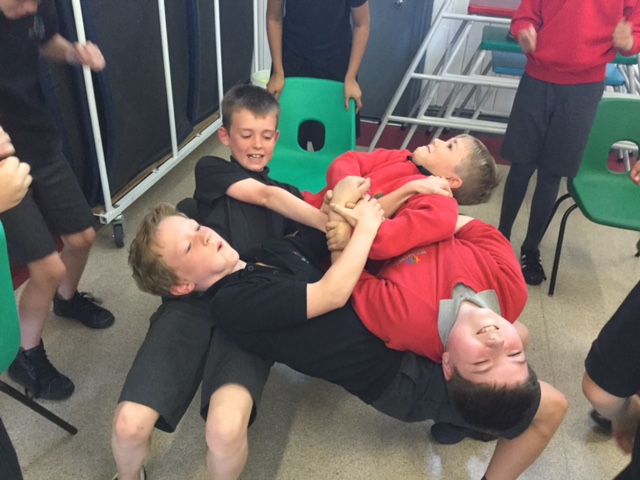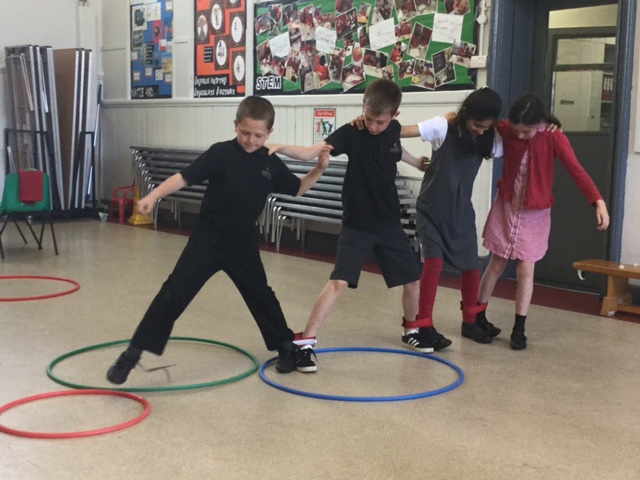School Library
Today, we visited the school library for the first time this year. We chose a book (which we will be taking home) and enjoyed relaxing and reading. Please remember that your child needs to return their library book, in good condition, every Thursday.





The Incredible Book Eating Boy art
This week, we’ve been reading a picture book: The Incredible Book Eating Boy. So far, we’ve used the book as a stimulus to learn how to justify our inferences during our reading lessons and in our writing lessons we’ve been focussing on the grammar skills needed to write a high-quality recount (next week we’ll be writing a recount as if we are Henry – The Incredible Book Eating Boy).
Today, we studied the illustrations in the book and compared them to other illustrations by Oliver Jeffers. We discovered that he has quite a specific style and then practised drawing ourselves in the style of Oliver Jeffers in our sketch books.
Here’s a few action shots:









Living and Learning
Living and Learning is our new name for SEAL (Social and Emotional Aspects of Learning).
Living and Learning will continue to cover SEAL learning but will also incorporate other aspects of PSHE (Personal, Social and Health Education) such as keeping safe, identity, drug education, physical health, rights and responsibilities and healthy minds.
We begin our Living and Learning learning this week with a focus on manners: I can greet someone politely.
For the rest of this half-term, we’re thinking about the ‘8 Rs for learning’. This theme is about promoting good learning behaviour for your child.
Each week, we’ll focus on two different ‘Rs’. We use an animal to symbolise each ‘R’, which might help your child remember all eight – can your child remember which animal matches the correct ‘R’?
You can support your child at home – we’ve listed a few ideas to help you below. Ask us if you’ve any questions or comments.
Download top tips for promoting the 8Rs for good learning behaviour.
I can show I am ready to learn.
Make sure your child is at school for a prompt start of 08:50.
Make sure your child has had plenty of sleep so they are alert and ready to learn at all times.
Encourage your child to ask lots of questions – that shows they want to learn!
I respond to feedback.
Ask your child if they remember their ‘stars’ and ‘steps’ in English and Maths.
I take a safe risk.
Talk about the difference between a safe and unsafe risk. At school, we want your child to take a safe risk by having a go at answering, even if unsure; trying something new and attempting harder learning.
I take responsibility for my own learning.
Provide time and space at home so your child is able to organise themselves: their PE kit, reading book, homework, spellings and tables… Don’t organise everything for them!
Make a link between rights and responsibilities: your child has the right to a great education, but needs to be responsible for their own learning.
I am resourceful.
Encourage your child to be organised so they can play with a range of different toys.
Encourage your child to try new ways to solve a tricky problem.
I am resilient.
Encourage your child to keep going! Set a tricky challenge or puzzle for your child to do.
Encourage your child to think of different ways of doing things.
Don’t let your child win when they play a game – they need to experience losing, too!
Celebrate mistakes as opportunities to learn – be happy that your child found some learning hard and encourage them to ‘bounce back’ and learn from the experience.
I remember.
Make sure they have time to learn spellings, number bonds and times tables – a little practice daily is best.
Play memory games:
Kim’s game: show them objects for 30 seconds… can they remember all the objects?
Can they build up the sequence, ‘I went to the shop and I bought an apple’… ‘I went to the shop and I bought an apple and a bike.’… ‘I went to the shop and I bought an apple, a bike and a cucumber.’ etc … Take turns!
I reflect about my learning.
Talk with your child about what they’ve learnt, asking questions about:
how they learnt
why they learnt it
when they’ll use their learning
how they would teach this to someone else
what learning might link with what they’ve learnt today etc
School meals
Following feedback from parents and pupils (School Council and pupil health questionnaires), and a successful trial of children selecting their main meal on Fridays, we will be extending this to every day from next week. Children will select their main meal choice at registration.
Please share the menu with your child so they are aware of the choices for each day.

Leeds Children’s Mayor voting
Congratulations to Pippa who was selected as our school entry and submitted her manifesto to be considered as the new Leeds Children’s Mayor.

Out of 48 entries, unfortunately Pippa wasn’t selected as one of the finalists.
Children are invited to vote for their two favourite manifestos from the twelve candidates.
The finalist who has the most votes when voting closes on 15 September will be elected as the new Children’s Mayor of Leeds.
Wow! What a year!
I’ve had a fantastic year and it has been great to see each child mature and make amazing progress. Each and every parent should be super proud!
Here’s a little note to each child:
Abdullah – You’ve really matured this year and this has been reflected in the super progress you have made. Keep it up!
Aleena – You know how to have fun yet you still work hard and make good choices – what a great mix!
Archie – You’ve become more confident as the year has progressed and your relentless effort is a really good example to your friends.
Brandon – What a lovely young man!. You are the most thoughtful, kind-hearted and genuinely nice person in the world!
Daanyaal – Mr Laidback became Mr Motivated. Well done, Dan!
Edward – You’ve made me laugh on many occasions this year. And, you’ve made me smile with the awesome progress you’ve made!
Elias– Being a maths genius is just one aspect of your amazing personality. You’ve had a great year – well done!
Enya – What can I say? You’ve helped, you’ve made me howl with laughter, you can be relied upon to finish the words to any pop song and you’ve absolutely smashed Year 5!
Grace – Disgrace: a very ironic nickname. You should be so proud of the immense effort you’ve put in this year. You are a great example to your peers and never fail to put a smile on our faces.
Harry – You are a very polite young man with an amazing ability to talk everyone round to your way of thinking – this is a rare skill!
Hibba – aka ‘The Sponge’! You have absorbed every bit of learning this year and have done extremely, extremely well as a result – I’m impressed!
Isobel – Not many 9 year olds are as confident in their own skin as you (not many adults in fact). You should be really proud of your non-stop effort!
Matteo – You have tried so hard in every aspect of your learning this year and have done incredibly well as a result. I am 100% confident you will smash Year 6 (and every year for that matter).
Matthew – I’ve really enjoyed getting to know you this year. I wish I could make you as confident in yourself as we all are in you!
Megan – You are a delight to teach. Your energy and enthusiasm infects every room you go in. Keep trying hard and being a bit silly!
Neive – ‘The Diva’. It’s been a pleasure to watch you mature over the year and you’ve made huge progress as a result.
Nico – A maths genius with creative flair. What a blend! Keep working hard and I’m sure you’ll do great.
Nishaan – You’ve improved your listening skills and have smashed the year as a result – well done!
Noah – Giddy, cheeky, sometimes silly – all of these things make you a pleasure to teach. Keep working hard as well (in all subjects!).
Oliver – A super hardworking young man. Keep making positive choices at all times and I know you’ll smash Year 6!
Owen – My fellow rugby nut. Keep transferring your skills from the pitch in to the classroom and you’ll enjoy a great year in Year 6.
Pavan – You’ve really come out of your shell and it’s been a pleasure to see you contribute more and more in lessons. Keep it up!
Pippa – You’ve had a superb year and have dazzled me with your maths and writing skills. Keep it up!
Pohnum – Your wonderful smile has made our class a great place to be! Keep up the hard work.
Saleem – You’re a very polite, helpful young man. Keep it up and I know you’ll have a great time in Year 6.
Sam – It’s been a pleasure to get to know you this year and you’ve amazed us all with your art.
Stan – aka ‘The Man’. I can always rely on you to make good choices and you are a great role model to your peers.
Umaimah – You’re sparky and bright. Use these attributes in the right way and I know you’ll go far.
Zack – It’s been a pleasure to teach you this year and I’ve seen you mature into a fine young man. Keep up the hard work!
Zeewa – You’ve channelled your creative flair this year and it’s been a pleasure to read your wonderful writing. Keep it up in Year 6!
Have a great summer holidays and come back refreshed and ready to smash Year 6 like you have Year 5!
Mr C
School Games Mark
At the end of each year, schools are invited to apply for their School Games Mark. The School Games Mark rewards schools for their commitment to and development of competition, school sport and physical education.
We are very proud to announce that our application has been verified and we have been awarded Gold award for the third year running.

In an attempt to engage as many children as possible in physical activity, we track children’s participation over the year.
68 children in KS2 and 52 children in KS1 and Reception have taken part in at least one after-school club since September. This is 57% of the total number of pupils.
81 children (68%) in KS2 have represented the school in a competition or participation event.
Children tell us they enjoy taking part in a variety of activitie:
- ‘In scooter club, I had fun on my scooter.’
- ‘I enjoyed Wake Up Shake Up club because I got to spend time with my friends and DANCE!’
- ‘I liked basketball. We learnt how to play the game, basketball skills and working as a team.’
- ‘I enjoyed cricket because it helped me with my skills of bowling and batting.’
- ‘I enjoyed the aqua festival. Everyone took part and nobody was left out. Everybody tried their best.’
- ‘The Brownlee Triathlon was fun and got people involved who don’t especially like sport but they did it. It wasn’t competitive.’
- ‘I enjoyed the Sportshall athletics competition because there were lots of events to choose from and do.’
Thank you to staff who have accompanied children to these events or run after-school clubs this year. Thank you also to Mrs Russell who provides excellent administration of our clubs and sporting events and competitions.
Thank you as well to all parents/carers who have helped with transport and supported at our events this year. Finally, thank you to all pupils who have tried out a new physical activity either at an after-school club or as part of a competition or participation event and to those children who have represented our school so well this year.


Yellow Yorkshire
Thank you for supporting our Yellow Yorkshire day to raise money for one of school charities, Yorkshire Air Ambulance.
Our final total raised was £202.31 so thank you for all your donations.
We also had a visit from a representative from Yorkshire Air Ambulance to hear how the money we raise is spent by the charity.



Transition to Y6
The Year 5s found out that they have the pleasure of me teaching them again next year – all of them were delighted of course!
We had a great afternoon discussing what skills we’d need in order to be successful in Year 6 and did lots of mini activities to test out those skills.
We tried out our listening skills while I read out some drawing instructions and the children tried following them. We discussed that we might makes mistakes in our learning because we aren’t listening. However, it is possible to listen carefully and not understand so we thought about what we needed to do if that was the case at some point next year.
Next, we tested our ability to work hard and be resilient. Building a tower out of cards was extremely frustrating and we linked it falling down to times when we don’t understand or get something wrong. Most of us proved to be very resilient.
There’ll also be lots of situations that will require us to work in a group or pair. So, we tested our ability to work as a team by creating some human tables; if one person doesn’t pull their weight, the table will fall which could also be the case if we’re trying to solve a maths problem together in class.


We also need to communicate when we work with others and the 5-legged challenge tested this.

What a great afternoon that will turn into a great year in September.
School Saving Club
The next School Saving Club paying in date is 13 July 2017 at 3.15-3.45pm.
If you’re unable to attend in person, please hand in any money to be deposited to the office in a sealed envelope addressed to Miss Hale.
This is the final paying in date for this year and dates for next year will be shared in September.
If your child would like to open account, please ask at the office.




